Research Projects
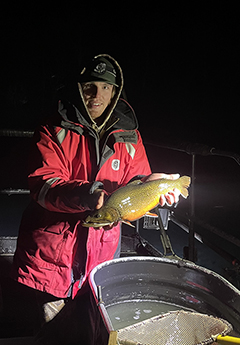
Brief summaries of graduate student research projects
partially supported by the GLSF are featured here. For more detailed information
on each project, follow the links to PDF files of the complete
document.
2024- In 2024, a GLSF Coaster Brook Trout Research Unit Grant was made to
Dylan Undlin, graduate student at University of Wisconsin, Stevens Point for his research project: Movements and habitat use of native Brook Trout and nonnative Salmonids in two Lake Superior watersheds. Dylan's faculty advisor is Dr. Justin VanDeHey.
Abstract: Dylan's graduate research is focused on identifying seasonal habitat use and movement patterns of Brook Trout and nonnative Salmonids in the Knife and Stewart rivers (and tributaries). This research represents an intense, multi-faceted project involving both active (radio-telemetry) and passive (PIT antennas) fish movement data collection, coupled with both active (thermal cameras on drones) and passive (in-stream data-loggers) longitudinal surveys of temperature, flow, oxygen, and physical habitats. The unique nature of the North Shore tributary streams (having both low and high gradient reaches, flashy flows, and limited groundwater influence), coupled with the combination of active and passive data collection at the watershed scale make this research relatively novel. Additionally, by surveying a watershed with nonnative Salmonids (Knife) and one with primarily just native Brook Trout (Stewart) we hope to elucidate how these species interact within these watersheds.
Dylan's research is a collaborative effort between UWSP, the Minnesota DNR and PCA, along with local conservation and angling clubs, and the Two Harbors High School Enviro Club.
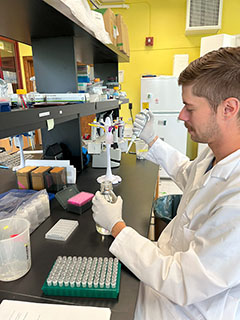 2023
2023- In 2023, a GLSF Coaster Brook Trout Research Unit Grant was made to
Ben Kline, graduate student at Michigan State University for his research project: Assessing genomic status and potential threats to
Brook Trout
Salvelinus fontinalis recovery in Lake Superior. Ben's faculty advisor is Dr. Mariah Meek. The project also expands upon the Coaster Genetics Project, conducted by Nick Peterson, MN Dept of Natural Resources, Lake Superior Area Fisheries.
Abstract: Brook trout (Salvelinus fontinalis) are one of only two charr native to the Lake Superior basin, and are a species of immense ecological, social, and cultural value in this region. Brook trout in the Lake Superior basin exhibit two life history forms: a resident form found only in streams and an endemic migratory form, known as coaster brook trout, which spends much of its life in the lake. Despite the importance of both life history forms, there is limited understanding of the relationships among resident and coaster brook trout, including which streams produce brook trout found in the lake, levels of genetic connectivity between populations, and the overall genetic health of populations. To address these knowledge gaps, we are examining genetic diversity and connectivity among brook trout along the Minnesota shoreline of Lake Superior to better characterize genetic health and relationships between resident and coaster brook trout.
Results from this study will help identify tributaries that are associated with coaster brook trout and will better inform conservation and management of both life history forms in the Lake Superior Basin.
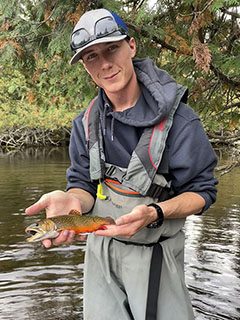 2022
2022- In 2022, GLSF Coaster Brook Trout Research Unit Grants were
awarded to two students who are working collaboratively, Danny McCann and Ben Schleppenbach.
An award was made to Danny McCann, graduate student at the University of Minnesota, Duluth for his research project: Prey-resource partitioning among Brook Trout Salvelinus fontinalis, Brown Trout Salmo trutta, Rainbow Trout Oncorhynchus mykiss, and Coho Salmon Oncorhynchus kisutch in the Bois Brule River, Wisconsin Danny's faculty advisors are Dr. Tom Hrabik and Dr. Joel Hoffman.
Abstract: Over the past century, intentional introductions of Brown Trout, Rainbow Trout, Coho Salmon, and Chinook Salmon into Lake Superior and its tributaries has resulted in a diverse assembly of resident and migratory salmonid species in the Upper Bois Brule River, Wisconsin. The introduced species listed above, along with native Brook Trout, occupy similar niches, and compete for resources such as food and space in the Upper Brule River. The first objective of this project was to compare prey selectivity among salmonids and determine if interspecific competition between species is reduced through resource partitioning. Gut contents and invertebrate samples were collected seasonally between 2021 and 2022. Preliminary results show that Brook Trout less than 300 mm in size have significant diet overlap with Browns and Rainbows in the fall. Interestingly, Brook Trout and Brown trout show similar patterns in seasonal foraging, having diverse diets in spring, predominantly terrestrial diets in summer, and a switch to benthic foraging in the fall, closely following seasonal prey availability. However, Brook trout had a more diverse diet year-round compared to other salmonids species, indicating niche separation and a possible strategy to avoid competition.
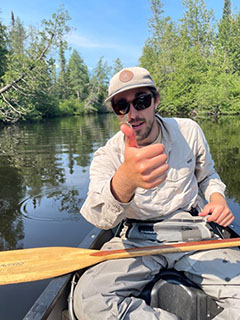
A simultaneous award was made to Ben Schleppenbach, graduate student at the University of Minnesota, Duluth for his research project: Inventory of spawning redd locations and habitat partitioning among brook trout Salvelinus fontinalis, brown trout Salmo trutta, rainbow trout Oncorhynchus mykiss, coho salmon Oncorhynchus kisutch, and chinook salmon Oncorhynchus tshawytscha in the Bois Brule River, Wisconsin. Ben's faculty advisors are Dr. Tom Hrabik and Dr. Greg Sass.
Abstract:
The Bois Brule River is a renowned, spring-fed, western Lake Superior tributary that supports five naturally reproducing populations of salmonid species: native brook trout, brown trout, rainbow trout, coho salmon, and chinook salmon. This sympatric mix of native and introduced species that includes potamodromous and stream resident life histories induces overlap of natural reproduction strategies and spawning habitat requirements. With increases in recreational angler use, combined with predicted changes to trout stream habitat in Wisconsin from a warming climate, understanding species interactions during spawning will become increasingly important to guide management of these sportfish populations. Our objective was to map species-specific spawning redd locations and evaluate physical, flow, and thermal conditions in these habitats during 2021 and 2022. Redd surveys were conducted by canoe over a nine-river mile section that encompassed historically important spawning areas. Preliminary results indicated spring spawning rainbow trout and fall spawning pacific salmon species are using the same spawning locations on larger gravel reefs in the center of the channel, downstream of riffle sections. Native brook trout were found spawning on smaller substrates with slower streamflow on the edges of the stream channel, with large congregations of spawning activity occurring in shoreline areas of lentic habitat. Results from this study provide valuable spawning habitat information and increase understanding of species interactions for stream habitat management of the Brule River in the future and may provide insight into management of other Great Lakes tributaries with similar sympatric, naturally reproducing salmonid species.
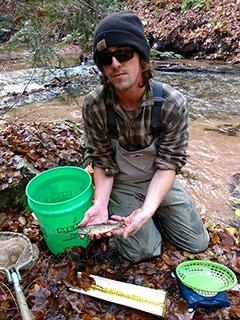 2019
2019- In 2019, GLSF Coaster Brook Trout Research Unit Grants were
awarded to two students.
An award was made to Chase Daiek, graduate student at Northern Michigan University, Marquette, MI for his research project: Effects of winter habitat variability on native age-0 brook trout (Salvelinus fontinalis) growth and survival. Chase's faculty advisor is Dr. Jill Leonard.
Abstract: Early life in fishes is often determinant of later growth and behavior that may impact differences in life history, including migratory and non-migratory strategies. Recent research in the Fish Biology Lab at Northern Michigan University has evaluated the effects of varying winter conditions on brook trout egg and hatched embryo survival and morphology. One of the most interesting outcomes was related to the behavior that occurs when young trout "swim up" or emerge out of their underground nests. The presumption is that young fish will swim up when they reach a particular developmental stage and/or when they use up the yolk sac, which supports them during early post-hatch development. However, we found that fish in different streams not only emerged from their redds at different times in the spring (predictable because of temperature differences), but that they emerged at dramatically different developmental stages. These findings have the potential to be important ecologically since the fish have a limited amount of time to develop before the onset of the next winter. The current study will seek to follow up on previous research at NMU by tracking the development of brook trout under different winter conditions starting at emergence, and following them through their second winter. This project will allow us to evaluate the importance of naturally occurring early life history differences on life history variation, and will help in predicting the importance of continued environmental change in streams in the face of ongoing climate change.
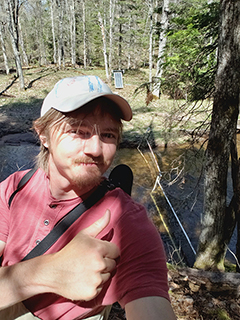
An award was also made to Chris Adams, graduate student at Michigan Technological University, Houghton, MI for his research project: Seasonal Habitat Use and Survival of Brook Trout (Salvelinus fontinalis) in the Pilgrim River, Houghton County, Michigan. Chris's faculty advisor is Dr. Casey Huckins.
Abstract:
The rehabilitation of Coaster Brook Trout is limited by a lack of understanding of habitat use, particularly in Michigan where few remnant populations exist. This study aims to gain information on seasonal movement patterns and survival of Brook Trout in the Pilgrim River, a Lake Superior tributary in Houghton County, Michigan. The Pilgrim River is one of eight Lake Superior tributaries in which the Michigan Department of Natural Resources implemented restrictive harvest regulations on downstream reaches to protect and enhance cryptic Coaster populations (one Brook Trout over 20 inches may be obtained). While these streams are suspected to historically support Coaster populations, their current presence has not been confirmed due to limited scientific information. Findings from this study will help to determine if a Coaster population is present in the Pilgrim River and understand how existing habitat being utilized throughout the year. Being able to document the Coaster life history in the Pilgrim River and obtain data on movement patterns is critical to justify continuation or alteration the harvest restriction and to inform potential habitat restoration efforts.
The objectives of this study are to 1) determine if Coaster Brook Trout are present in the Pilgrim River, 2) describe the timing and extent of movements with the river, particularly among protected and unprotected reaches, and into the Keweenaw waterway, and 3) evaluate seasonal survival in those three locations. These objectives will be address by evaluating watershed-scale movements of individually tagged Brook Trout for multiple years. Link to detailed abstract: Seasonal Habitat Use and Survival of Brook Trout (Salvelinus fontinalis) in the Pilgrim River, Houghton County, Michigan
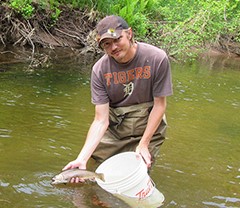 2018
2018- The 2018 Grant Program was modified this year in order to take advantage of the 2018 International Charr Symposium, held in Duluth, Minnesota June 18-21. In lieu of a grant to an individual student, the GLSF offered financial assistance to qualifying graduate students to attend the symposium. Three students were sponsored to attend.
Chris Adams is a graduate student at Michigan Technological University, Houghton, MI. Chris's faculty advisor is Dr. Casey Huckins.
Statement: Chris is using PIT tags and in-stream antenna stations to monitor movements of Brook Charr in a southern Lake Superior tributary with special management regulations in place designed to protect potentially migratory Brook Charr. Preliminary findings indicate that a migratory Coaster Brook Charr population is persisting in this river system, and valuable information regarding the timing and extent of movement is being obtained. Chris presented his research at the 2018 International Charr Symposium.
Photo: Chris Adams with a Brook Charr (Salvelinus fontinalis).
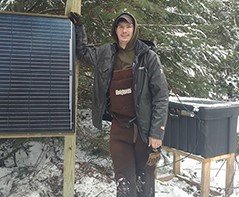
Jacob Bowman is a graduate student at Northern Michigan University, Marquette, MI. Jacob's faculty advisor is Dr. Jill Leonard.
Statement: My area of interest is in individual movement patterns of brook trout and how their metabolism relates to those patterns of movement. I seek to understand how the metabolic physiology of individuals determines their life history characteristics, including migration and movement within streams.
Photo: Jacob Bowman with the solar panels and reader that power the PIT tag/RFID array in the Rock River, MI.
Grace Zimmerman is also a graduate student at Northern Michigan University, Marquette, MI. Grace's faculty advisor is Dr. Jill Leonard.
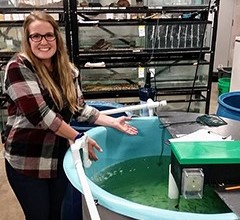
Statement: I am looking at the influence of food availability and temperature on individual differences in metabolic rate in brook trout (Salvelinus fontinalis). We are interested in characterizing individual variability in metabolism, which can correlate to behavior and life history-related characteristics, including migration. Our goals are to evaluate the consistency of metabolic rate within and between individuals of the same cohort with the same rearing conditions and to evaluate whether different estimators of metabolic rate result in similar rankings between individuals.
Photo: Grace Zimmermann standing next to a set of her research tanks at the Fish Biology Research Lab at Northern Michigan University.
Link to the video taped proceedings of the 2018 Charr International Symposium:Videos of the 9th International Charr Symposium.
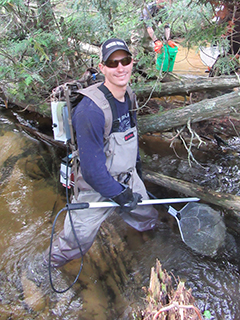 2017
2017- The 2017 GLSF Coaster Brook Trout Research Unit Grant was
awarded to
Jacob Bowman, graduate student at Northern Michigan University, Marquette, MI for his research project: A Link Between Metabolic Rate and the Life History Strategies of Brook Trout. Jacob's faculty advisor is Dr. Jill Leonard.
Abstract: Brook trout are one of many species that exhibit intraspecific life history variation across their range including our locality, Lake Superior. The most notable of these life histories is the coaster brook trout. Coaster brook trout have been ruled out as a subspecies because of a lack of genetic distinction and has failed recognition as a distinct vertebrate population segment from a petition for the endangered species list. In addition, metabolism is related to behaviors like aggression emigration and is a predictor for ecotonal habitat selection in related taxa. Researchers are also providing evidence that the decision to emigrate may be within individual metabolic variation. It is for these reasons that we seek to understand the role metabolism plays in movement patterns of brook trout within a local watershed. The Rock River provides a diverse habitat with different environmental variation within its tributaries. We will place RFID antenna's and track brook trout movement throughout the watershed increasing our coverage as years persist. These brook trout will be tagged and have oxygen consumption measured for metabolism through intermittent flow respirometry. There are many different causes for movement within a population including thermal and flow variation, seasonal movements like reproduction and emigration. We plan to use these movement patterns in conjunction with metabolism in individual brook trout to determine what metabolic traits correlate with timing of movement and more importantly which individuals decide to emigrate from a localized area within the stream.
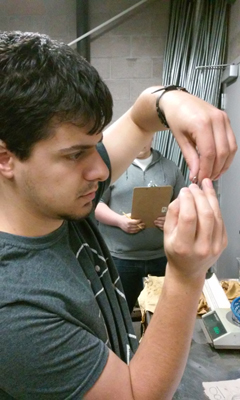 2016
2016- The 2016 GLSF Coaster Brook Trout Research Unit Grant was
awarded to
Spenser Chicoine, graduate student at Northern Michigan University, Marquette, MI for his research project: Effects of Summer and Winter Thermal Variability Regimes on Growth and Metabolism of Coaster Brook Trout. Spenser's faculty advisor is Dr. Jill Leonard.
Abstract: Spenser's research seeks to address how varying thermal regimes may affect fitness and survival of coaster brook trout through losses in growth. Much of our understanding of how brook trout biology is affected by thermal conditions focuses on the heat of summer. The cold of winter may have its own harmful effect that is essential for conservation workers to understand. It is also important to consider that an organism is subject to the extreme conditions of its environment, not just the mean. It is essential that we account for the effects of thermal variation, and not just compare seasonal averages, when describing the effects of temperature. This will allow for a more accurate understanding of the coaster brook trout's habitat requirements, and better assessment of suitable habitat for restoration efforts.
This study is being carried out in the Fish Biology Lab at Northern Michigan University. Spenser is rearing his fish, Tobin Harbor coasters, in tanks in a laboratory setting allowing him to apply experimental treatments to different groups. One group of fish is being held at constant temperature, while the two others are exposed to a daily cycle of temperature fluctuation. These cycling treatments differ in strength. One varies by about 4°C daily to represent current climate conditions. The other varies by about 8°C daily, representative of potential end-of-century conditions according to climate change projections. As the fish are raised under these treatments, they will be monitored for growth, and biological indicators of stress.
This project is currently underway, and is on track to be completed early this fall. Spenser is finishing his first year as a graduate student at NMU, and hopes to continue on an academic research career following the completion of this program.
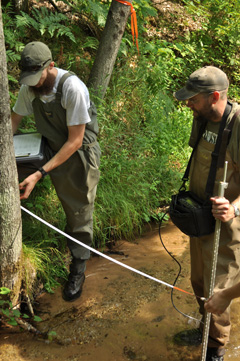 2015
2015- The 2015 GLSF Coaster Brook Trout Research Unit Grant was
awarded to
Brian Danhoff, graduate student at Michigan Technological University,
Houghton, MI for his research project: Potential Use of Large Woody Debris For the Restoration of Instream Substrates.
Brian's faculty advisor is Casey Huckins, Ph.D.
Abstract: It has been well documented in scientific literature that heightened aggradation of fine sediments (e.g., sand) in cold-water trout streams can negatively impact instream habitat for fish and other biota. The Salmon Trout River, Marquette County, which currently supports a critical remnant population of Coaster Brook Trout (Salvelinus fontinalis), has been impacted by fine sediments over the past decade, and in particular since at least 2007, when large lobes of sand were observed encroaching on an important Brook Trout spawning location in a lower reach of the river. Logging activities and improper roads and crossings in small tributaries to the Salmon Trout River are believed to have caused the erosion of fine sediments from the upland that were transported downstream into the river. The majority of the lower Salmon Trout River is now aggraded with sand, which has removed much of the instream habitat complexity and embedded larger substrates needed by coldwater fish and much of their prey. In 2013 a successful effort was made to remove much of the sand and expose previously embedded substrates in a primary Coaster Brook Trout spawning location of the Salmon Trout River using a technique developed by Streamside Environmental LLC. We have also installed a sediment collector upstream that was designed to reduce bedload transport of fines downstream thus protecting the restored site. This requires routine maintenance and operation of the gas powered pump and it is likely under matched to deal with the extreme sand bedload so the site occasionally gets overtopped with sand. While successful at this small scale of the spawning site, it is not a solution for greater areas of the river and not transportable to other spawning areas currently embedded with fines. Much of the interstitial spaces previously used by Coaster Brook Trout and several species of invertebrates in the lower river have been filled in by this fine sediment. In these other sites we are proposing to use introduced large wood as a tool to restore some of the substrate heterogeneity (i.e. habitat complexity/patches of exposed large substrates) and spawning locations in the lower Salmon Trout River. Our long-term data set shows this upstream site being an active spawning area prior to the sand aggradation. Added wood will introduce small scale sites of hydraulic scour that will mobilize and aid in the downstream transport of sand. If successful in helping to mitigate some of the negative effects of sand and expose these important substrates in another upstream spawning site, wood in the stream would have the added benefit of acting as refuge and rearing habitat for juvenile Coaster Brook Trout.
Prior to adding large woody material to the Salmon Trout river baseline data on the distribution of wood in the channel as well as associations between woody debris and sediment composition in the lower Salmon Trout River must be quantified. A longitudinal survey will be conducted of the physical characteristics of the channel. A crew will walk upstream in the channel measuring key large wood debris ?0.1 m in diameter and ?0.5 meters in length. Additional characteristics for wood will be recorded for each piece or jam including: orientation in the channel, whether or not a root wad is present, and number of pieces or total dimension for log jams. Substrates and channel morphology (e.g. wetted width, channel depth) will be measured at equally spaced transects within the study reach. GPS will be used to record the location of woody material in the river channel and this data will be characterized spatially along with channel and substrate data using Arcmap 10.1 (©ESRI). This data will provide a baseline condition of the current distribution of wood, physical characteristics in the channel and their association, as well as an estimation of substrate heterogeneity prior to wood additions. The associations between instream wood and streambed substrates will be used to guide future project planning and allow for the determination of the efficacy of woody material additions locally removing fine sediments and exposing larger substrates thus restoring old spawning sites and adding complexity to Coaster Brook Trout habitat. If successful, this technique could be an efficient low-maintenance solution to the preponderance of aggraded coldwater streams with limited trout spawning and rearing habitat.
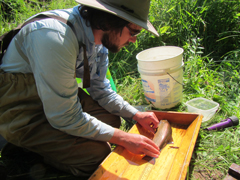 2014
2014- The 2014 GLSF Coaster Brook Trout Research Unit Grant was
awarded to
Tony Matthys, graduate student at Michigan Technological University,
Houghton, MI for his research project: Monitoring of a Sediment Removal Restoration and Assessing the Functionality of an Active Sediment Removal Array.
Tony's faculty advisor is Casey Huckins, Ph.D.
Abstract: With the aid of critical funding provided by the Greater Lake Superior Foundation we continue to study the effects of stream habitat conditions on Brook Trout ecology and behavior, and monitor the response of juvenile coaster brook trout to a sediment removal restoration. Beginning in 2012, we initiated the restoration of a coaster brook trout spawning site that had over the years been increasingly threatened and degraded by sand moving downstream from watershed disturbances. The restoration involved the removal of fine sediments from the site and the deployment of a series of active sediment collectors to prevent new fine sediments from burying the exposed large substrates in the restoration site in an effort to protect the important coaster brook trout spawning habitat. With the help of GLSF funding I was able to use this restoration as an experimental test of the importance of streambed substrates as factors influencing the habitat selection decisions made by juvenile coaster brook trout.
We will be continuing this work this summer by conducting a second season of habitat preference surveys to address the longer term pattern of juvenile coaster brook trout habitat use. These surveys measure the rates of immigration and emigration at the restoration site and two nearby reference sites. These movement rates can then be used a proxy for habitat preference. Last summer we observed that preference juveniles showed for the site increased substantially after sand was removed. We look forward to measuring the interannual variability in habitat preference as well as response to the restoration one year later. We predict that the exposed large substrates of the restoration site will continue to be attractive habitat to juvenile coasters.
Additionally, we will assess the how well the sediment collectors are protecting the restoration site by conducting detailed habitat surveys of the restoration site and the nearby reference sites. These surveys allow us to map embeddedness, sand depth, water depth and velocity. These surveys will tell show whether the collectors are working in the Salmon Trout River or if other more aggressive sediment control strategies are needed to protect this important coaster brook trout spawning habitat.
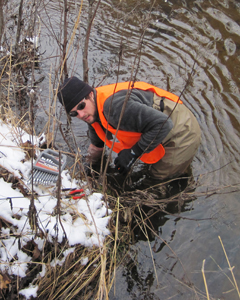 2013
2013- The 2013 GLSF Coaster Brook Trout Research Unit Grant was
awarded to
Tony Matthys, graduate student at Michigan Technological University,
Houghton, MI for his research project: Assessing the Impact of a Sediment Removal Restoration on Juvenile Coaster Brook Trout Habitat Preference.
Tony's faculty advisor is Casey Huckins, Ph.D.
Abstract: The Salmon Trout River, Marquette County, MI, contains the largest known and verified reproducing remnant population of adfluvial coaster brook trout on the south shore of Lake Superior.
However, fine sediment aggradation has increased in this system, potentially reducing the in-stream habitat quality for juvenile coasters. Our previous research suggested that in sandy segments of the Salmon Trout River, even relatively small patches of exposed large substrate (e.g. pebbles, cobbles, boulders)
correlate to higher juvenile coaster brook trout preference for a site. This indicates that exposed large substrates may be strong drivers of perceived habitat quality in sandy streams.
My current research uses an ongoing spawning site restoration, where sediments are being collected and removed, as an experimental habitat manipulation.
This allows us to experimentally test the effect of aggraded (and removed) sand on juvenile coaster brook trout habitat preferences.
This study began in 2012, when we measured habitat preferences at the restoration site and two nearby reference sites before the restoration began.
In the summer of 2013, we will measure habitat preferences again after the restoration has removed enough sand to expose more large substrates.
This work seeks to provide restoration and management groups with information to more efficiently restore or improve habitat for brook trout both within the Salmon Trout River and throughout the Lake Superior basin.
For instance, if the relationship between habitat preference and sediments I observed during my previous research is corroborated with this project, then we would have strong evidence that in sandy streams exposed large substrates are the main driver of brook trout habitat preference.
This information could then be used to prioritize restoration that exposes large substrates in sandy streams over other habitat improvement strategies.
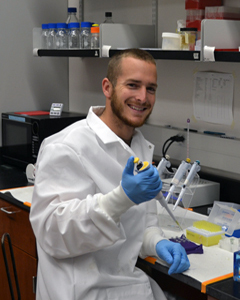 2012
2012- The 2012 GLSF Coaster Brook Trout Research Unit Grant was
awarded to
Jonathan Pearce, graduate student at Northern Michigan University,
Marquette, MI for his thesis project: Genetic Investigation of Coaster Brook
Trout in Pictured Rocks National Lakeshore. Jonathan's faculty advisor is
Katherine Teeter, Ph.D.
Abstract: Brook Trout (Salvelinus fontinalis) found in the Lake
Superior basin present significant difficulties for fisheries managers due to the complexity of this species.
In the Lake Superior basin brook trout display three major life histories including stream resident,
adfluvial and lacustrine coasters, which have been recognized by federal, state, provincial, and tribal agencies as important to management concerns.
There is a need to clarify the delineation of populations as well as metapopulations around
Lake Superior using genetic techniques that characterize appropriate management units based upon
the amount of genetic divergence between recognized populations. Our study being conducted
in Pictured Rocks National Lakeshore (PIRO) is sitting at the nexus of these issues as we
intend to determine the genetic interrelationships between assumed populations of brook trout
(watershed groups) that are known to be connected by the movement of individuals (i.e. coaster brook trout).
Funding from the NPS will allow us to determine the genetic population structure of the PIRO brook
trout in 6 watersheds in the park (Sable R., Hurricane R., Sullivan's Cr., Sevenmile Cr., Mosquito R., and Miners R.).
We will determine the genetic relationship between downstream (access to Lake Superior) and upstream (restricted headwater) sections as well as between watershed comparisons.
Funding from the GLSF will allow the analysis of known coaster brook trout from PIT tag radio telemetry data on three of the watersheds (Hurricane R., Sevenmile Cr., and Mosquito R.).
Fish that have out-migrated from the stream into Lake Superior will be considered a coaster. Management decisions will be formulated by PIRO and MI DNR Biologist based on findings from the proposed study. The increased knowledge of the genetic structure found in the park will help further the conservation of brook trout in the Lake Superior basin and insight into the unique ecotype of the coaster brook trout.
Publication of the study was completed in the summer of 2013.
Link to completed study: Chapter Three: Genetic Investigation of Adfluvial Brook Trout in Pictured Pocks National Lakeshore
 Brief summaries of graduate student research projects
partially supported by the GLSF are featured here. For more detailed information
on each project, follow the links to PDF files of the complete
document.
Brief summaries of graduate student research projects
partially supported by the GLSF are featured here. For more detailed information
on each project, follow the links to PDF files of the complete
document.














